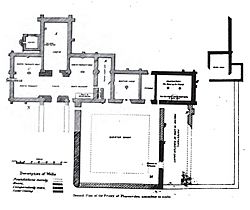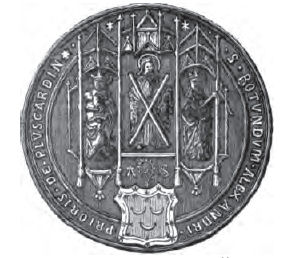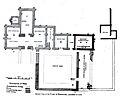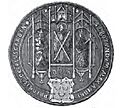Pluscarden Abbey facts for kids
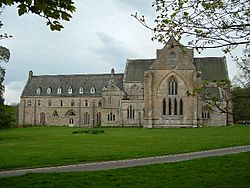 |
|
| Monastery information | |
|---|---|
| Order | Benedictine |
| Established | c.1230 |
| Disestablished | 1587 |
| Reestablished | 1948 |
| Mother house | Prinknash Abbey (Prev. Val des Choux; Dunfermline Abbey) |
| Dedicated to | Our Blessed Lady, Saint John the Baptist and Saint Andrew |
| Diocese | Diocese of Aberdeen (present) Diocese of Moray (historical) |
| People | |
| Founder(s) | Alexander II of Scotland |
| Important associated figures | Lord Colum Crichton-Stuart |
| Site | |
| Coordinates | 57°36′01″N 03°26′18″W / 57.60028°N 3.43833°W |
Pluscarden Abbey is a Catholic Benedictine monastery located in a valley in Scotland. It's about 6 miles southwest of Elgin, Moray. King Alexander II started it in 1230 for a group of monks called the Valliscaulian Order.
In 1454, Pluscarden Priory joined with another monastery called Urquhart. It then became a Benedictine house. Over time, especially after the Scottish Reformation, the priory fell into disrepair. By 1680, it was mostly ruins. Some efforts were made to fix it in the late 1800s.
In 1948, the priory became home to Benedictine monks from Prinknash Abbey in England. They began to restore the buildings. Pluscarden became independent in 1966 and was made an abbey in 1974.
Contents
History of Pluscarden Abbey
What's in a Name?
The name Pluscarden is quite old and its exact meaning is a bit of a mystery. The earliest records show it as Pluscardyn in 1226.
Some experts think the second part, -carden, might mean "an enclosure" or a fenced-off area. The first part, Plus-, could come from an old language like Pictish or Gaelic. It might relate to words meaning "eggshell" or "height". So, it could mean something like "enclosure on the height" or "eggshell enclosure".
The First Monks: Valliscaulian Priory
King Alexander II founded Pluscarden as a Valliscaulian priory. This was a small order of monks, different from the larger ones you might know. They followed strict rules for their religious life.
The Valliscaulian Order started in France, near a place called Val des Choux. Their rules were approved by Pope Innocent III in 1205. These rules were similar to those of the Cistercian monks. One unique rule was that monks had their own small gardens. Also, a priory (a type of monastery) was not supposed to have more than 20 monks. This small size meant they needed rich supporters to survive.
There were only 21 Valliscaulian houses in total, and three of them were in Scotland: Pluscarden, Beauly, and Ardchattan.
King Alexander II gave Pluscarden Priory a lot of land and resources. This included income from mills in nearby towns. They also had rights to fish for salmon in the Findhorn and Spey rivers. Pluscarden even got a share of the iron mined in the local forests. All these gifts helped the priory to do very well.
It's believed that Pluscarden Priory suffered two fires in the 1300s. One was in 1303, possibly caused by Edward I of England. The second was in 1390, perhaps by a Scottish nobleman known as the Wolf of Badenoch. Evidence shows there was a big fire. The damage to parts of the church was never fully fixed, suggesting they didn't have enough money.
By the 1400s, the priory faced hard times. Its income was falling, and contact with France was difficult due to the Hundred Years' War. There were also arguments about who should be in charge.
Becoming a Benedictine Priory
In 1453, the Prior (leader) of Urquhart monastery asked the Pope to combine his monastery with Pluscarden. At that time, Urquhart had only two monks, and Pluscarden had six. Pope Nicholas V agreed, and the two priories merged. Pluscarden then became a daughter house of the larger Dunfermline Abbey, which was Benedictine.
Pluscarden was chosen as the main location because its buildings were bigger and easier to fix. The first Benedictine Prior of Pluscarden was John Bonally. However, the abbey needed a lot of repairs. The roofs of the church were in danger of falling down.
After some problems, John Bonally resigned. William Boyce, a monk from Dunfermline Abbey, became the new Prior. He was responsible for maintaining Dunfermline Abbey's church. It's thought that he made major improvements at Pluscarden during his time. By 1506, King James IV even stayed at the priory and gave money to the masons working there.
In the 1500s, the number of monks at Pluscarden grew. There were seven monks in 1500, and thirteen in 1524. However, after the Scottish Reformation, the number of monks decreased. By 1561, there were only five monks left.
The last two priors before the Reformation were George Learmonth and Alexander Dunbar. After them, the priory was managed by lay (non-monk) leaders. These leaders looked after the abbey's money and the few remaining monks. The last monk recorded at Pluscarden was Thomas Ross in 1586. After this, the abbey no longer had a community of monks.
During the 1600s, Pluscarden Priory became very ruined. Its stones were even used to rebuild a church in Elgin. Later, the Earls of Fife owned the land. The 4th Earl stopped further damage by turning part of the east building into a hunting lodge. In 1897, John Crichton-Stuart, 3rd Marquess of Bute bought the property and started restoring the church. But he died in 1900, and the work stopped.
Pluscarden Becomes an Abbey Again
Lord Colum Crichton-Stuart, who owned Pluscarden, gave the priory and its land to Prinknash Abbey in 1943. Monks from Prinknash arrived in 1948. Within seven years, the church's bell tower had a new roof.
Restoration work continued steadily. In 1966, Pluscarden Priory became independent from Prinknash. Then, in 1974, it was officially made an Abbey.
In 1987, Pluscarden Abbey took on the responsibility for St. Mary's Monastery in Petersham, USA. This meant St. Mary's became a "dependency" of Pluscarden. In 2011, Dom Anselm Atkinson, who had been in charge of St. Mary's, was chosen as the new Abbot of Pluscarden.
Today, Pluscarden Abbey welcomes visitors and sometimes holds special retreats. Guests are often asked to help with work around the abbey. Silence is usually kept in the church, dining hall, and other areas where the monks live and pray.
Images for kids



